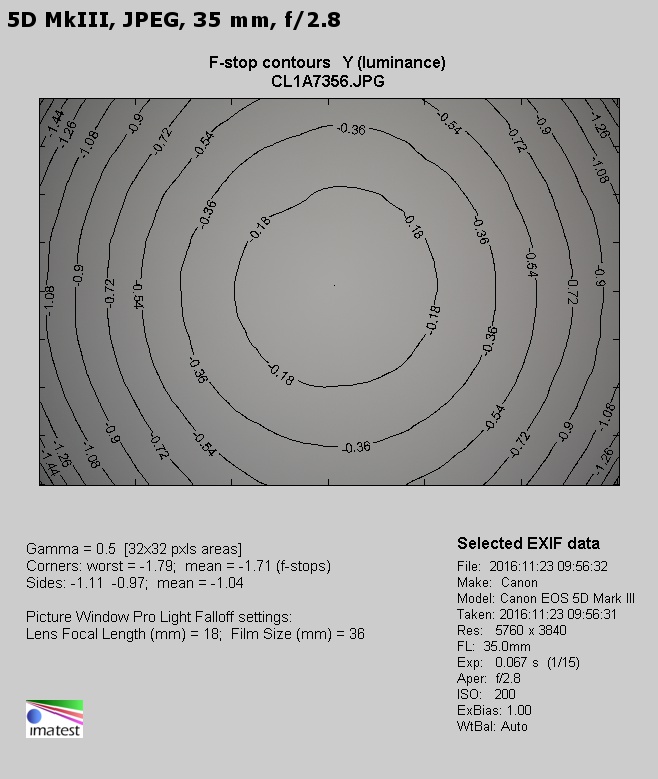Canon EF 16-35 mm f/2.8L III USM
8. Vignetting
| Canon 50D, 16 mm, f/2.8 | Canon 50D, 16 mm, f/4.0 |

|

|
| Canon 50D, 24 mm, f/2.8 | Canon 50D, 24 mm, f/4.0 |

|

|
| Canon 50D, 35 mm, f/2.8 | Canon 50D, 35 mm, f/4.0 |

|

|
At 16 mm and f/2.8 the vignetting is noticeable even on the smaller sensor. We got a result of 33% (−1.18 EV). Fortunately for f/4.0 and f/5.6 apertures the problem becomes negligible with values of 13% (−0.42 EV) and 10% (−0.32 EV) respectively.
Please Support UsIf you enjoy our reviews and articles, and you want us to continue our work please, support our website by donating through PayPal. The funds are going to be used for paying our editorial team, renting servers, and equipping our testing studio; only that way we will be able to continue providing you interesting content for free. |
- - - - - - - - - - - - - - - - - - - - - - - - - - - - - - - - - - - - - - - - - - - - - - - -
At the 24 mm focal length you get a bit lower vignetting level because, with the lens wide open, the light fall-off in the frame corners reaches 28% (−0.94 EV). Once again the problems end by f/4.0 and f/5.6 where the aberration described here decreases to 10% (−0.31 EV) and 7% (−0.21 EV) respectively.
You experience the least problems at 35 mm where, by f/2.8, the vignetting is just 20% (−0.65 EV) and it goes down to 7% (−0.20 EV) after stopping down the aperture to f/4.0.
Now let’s check the situation on full frame – the appropriate thumbnails are presented below.
| Canon 5D III, 16 mm, f/2.8 | Canon 5D III, 16 mm, f/4.0 |

|

|
| Canon 5D III, 24 mm, f/2.8 | Canon 5D III, 24 mm, f/4.0 |

|

|
| Canon 5D III, 35 mm, f/2.8 | Canon 5D III, 35 mm, f/4.0 |

|

|
It would be difficult to call this situation other than dramatic. Such high vignetting we haven’t seen so far in our tests. At 16 mm and by f/2.8 in the frame corners disappears 75% of light (−4.07 EV). On stopping down the aperture to f/4.0 the situation improves but still the vignetting remains very high, reaching 57% (−2.47 EV). You can notice it without any problems by f/5.6 and f/8.0 where it is respectively 40% (−1.50 EV) and 32% (−1.10 EV). Even by f/11 and f/16 the problem remains noticeable (27% and −0.93 EV).
By the 24 mm focal length the situation is better but still far from good. By employing the maximum relative aperture you must take into account losing 58% of light in the frame corners (−2.52 EV). On stopping down the aperture to f/4.0 the vignetting decreases to 34% (−1.21 EV) and further stopping down to f/5.6 makes it drop to 23% (−0.77 EV). Only by f/8.0 and f/11 you can talk about a small level of that aberration, with results amounting to 17% (−0.52 EV) and 15% (−0.46 EV) respectively.
The least vignetting problems you can observe at the 35 mm focal length where, at the maximum relative aperture, that aberration reaches 45% (−1.17 EV), and at f/4.0 it decreases to 23% (−0.77 EV). The issues are practically over by f/5.6 where the vignetting value measured by us amounted to 10% (−0.32 EV).
 |
 |
 |






